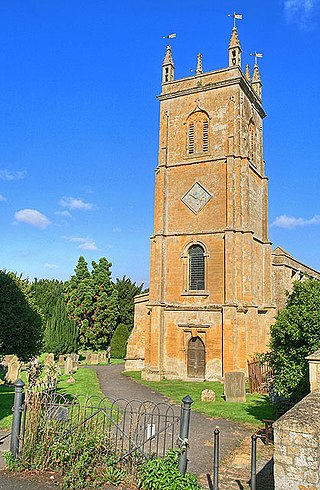
Cirencester is a market town in Gloucestershire, England, 80 miles (130 km) west of London. Cirencester lies on the River Churn, a tributary of the River Thames. It is the eighth largest settlement in Gloucestershire and the largest town within the Cotswolds. It is the home of the Royal Agricultural University, the oldest agricultural college in the English-speaking world, founded in 1840. The town had a population of 20,229 in 2021.

A wool church is an English church financed primarily by donations from rich merchants and farmers who had benefitted from the medieval wool trade, hoping to ensure a place in heaven due to their largesse.

Manchester Cathedral, formally the Cathedral and Collegiate Church of St Mary, St Denys and St George, in Manchester, England, is the mother church of the Anglican Diocese of Manchester, seat of the Bishop of Manchester and the city's parish church. It is on Victoria Street in Manchester city centre and is a grade I listed building.

Halifax Minster is the minster church of Halifax, Calderdale, West Yorkshire, England. The church is dedicated to St John the Baptist. The parish church of the town, it was granted minster status in 2009. Halifax Minster is one of three churches in the county of West Yorkshire to be given this honorific title; the other two are Dewsbury Minster and Leeds Minster.

Northleach is a market town and former civil parish, now in parish Northleach with Eastington, in the Cotswold district, in Gloucestershire, England. The town is in the valley of the River Leach in the Cotswolds, about 10 miles (16 km) northeast of Cirencester and 11 miles (18 km) east-southeast of Cheltenham. The 2011 Census recorded the parish's population as 1,854, the same as Northleach built-up-area.

St Edmundsbury Cathedral is the cathedral for the Church of England's Diocese of St Edmundsbury and Ipswich. It is the seat of the Bishop of St Edmundsbury and Ipswich and is in Bury St Edmunds in Suffolk. Originating in the 11th century, it was rebuilt in the 12th and 16th centuries as a parish church and became a cathedral in 1914; it has been considerably enlarged in recent decades.

Coln Rogers is a village and former civil parish, now in the parish of Coln St. Dennis, in the Cotswold district of the county of Gloucestershire, England. In 1931 the parish had a population of 95.

Shipton Moyne is a village and civil parish in the Cotswold district of Gloucestershire, England, approximately 105 miles west of London. Its nearest towns are Tetbury, also in Gloucestershire, and Malmesbury in Wiltshire. The population taken at the 2011 census was 265.

St Michael's Church is a Church of England parish church in St Albans, Hertfordshire, England. Much of the building is late 10th or early 11th century, making it the most significant surviving Anglo-Saxon building in the county. It is located near the centre of the site of Roman Verulamium to the west of the modern city.

Fulbrook is a village and civil parish immediately northeast of Burford in West Oxfordshire. The 2011 Census recorded the parish's population as 437.

Clanfield is a village and civil parish about three miles (5 km) south of Carterton, Oxfordshire. The parish includes the hamlet of Little Clanfield one mile (1.6 km) west of the village, on Little Clanfield Brook which forms the parish's western boundary. The parish's eastern boundary is Black Bourton Brook and its southern boundary is Radcot Cut, an artificial watercourse on the River Thames floodplain. The 2011 Census recorded the parish's population as 879.

St Michael's Church is an Anglican church in the Cotswold village of Duntisbourne Rouse, Gloucestershire, England. It dates from no later than the 11th or 12th century and, since 1958, has been designated a Grade I listed building. It is an active parish church in the Diocese of Gloucester, the archdeaconry of Cheltenham and the deanery of Cirencester.

St Saviour's Church is a historic 19th-century Anglican church in the town of Tetbury, Gloucestershire, England under the care of The Churches Conservation Trust. It was designed by the architect Samuel Daukes. Augustus Welby Northmore Pugin and John Hardman undertook the design and execution of the chancel roof. St Saviour's is recorded in the National Heritage List for England as a designated Grade II* listed building.

The Church of St Mary the Virgin is a Church of England parish church in Meysey Hampton, Gloucestershire. It is in the Diocese of Gloucester and the archdeaconry of Cheltenham. It is a Grade II* listed building.

St James Church is a Church of England church in School Lane, Quedgeley, Gloucester, Gloucestershire, England. It was designated as a Grade II listed building in January 1955.

The Church of St Peter and St Paul is a Church of England parish church in Blockley, Gloucestershire, England. The church is a Grade II* listed building. In addition to being an active Anglican parish church, it appears in the television series Father Brown as the village's Roman Catholic church.

The Anglican Church of St Margaret at Bagendon in the Cotswold District of Gloucestershire, England was built in the 12th century. It is a grade I listed building.

The Anglican Church of St Leonard at Bledington in the Cotswold District of Gloucestershire, England, was built in 12th century. It is a grade I listed building.

The Anglican Church of St Peter at Farmington in the Cotswold District of Gloucestershire, England was built in the 12th century. It is a grade I listed building.

The Anglican Church of St Andrew at Coln Rogers in the Cotswold District of Gloucestershire, England was built in the 11th century. It is a grade I listed building.




























